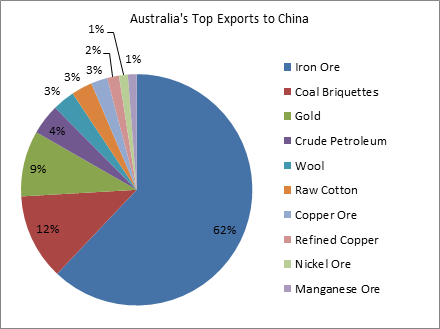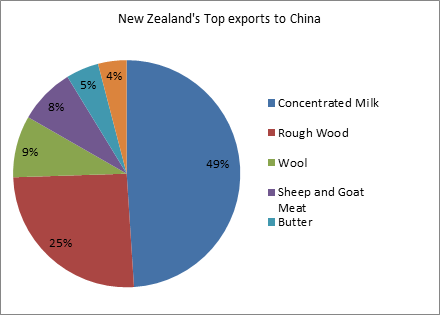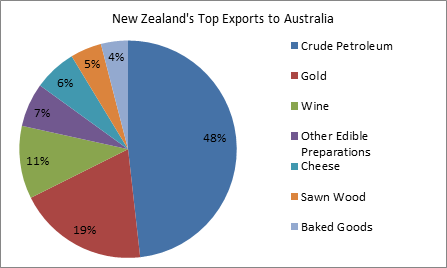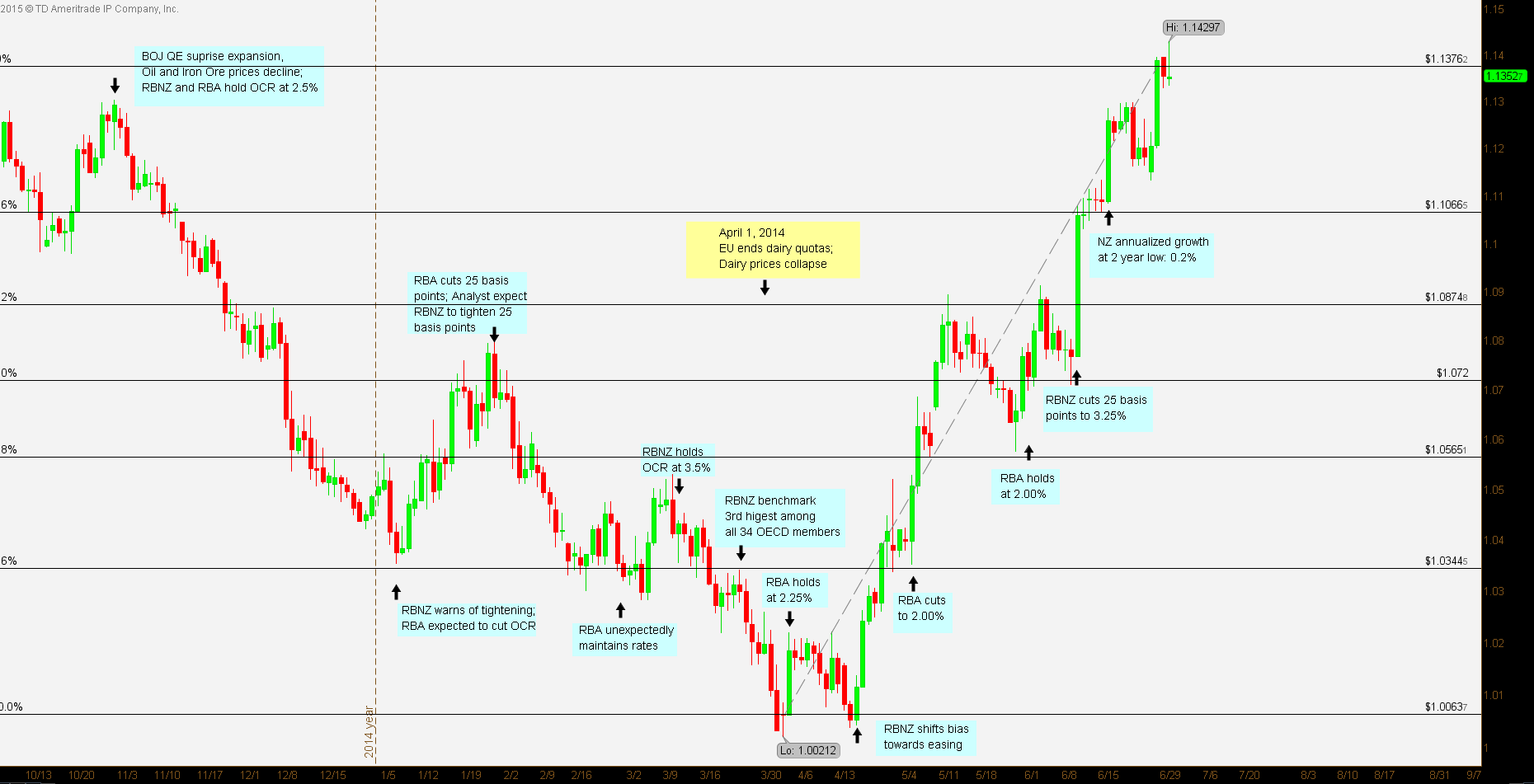As commodity export economies, both New Zealand and Australia are heavily affected by demand from China. New Zealand’s exports to China are mostly agricultural, particularly dairy, mostly concentrated milk accounting for over 30% of all exports to China. With the exception of ‘rough wood’, over 43% of New Zealand’s top exports to China are agricultural and over 93% of those agricultural exports may properly be classified as ‘Consumer Staples’. China is New Zealand’s #2 trading partner at over 19% of all exports.


On the other hand, 9 of Australia’s top 10 exports to China are most definitely cyclically sensitive: partially refined or raw metal ores and petroleum, crude and refined, accounting for over 75% of total exports to China. In other words, nearly 90% of its top exports are sensitive to China’s economy. Lastly, at 29% of all Australian exports, China is its top export partner.
On the other hand, New Zealand’s top export partner happens to be Australia. As strange as it might sound, its largest export to Australia is Crude Petroleum; 18.84% of all exports. A quick mention is warranted on New Zealand’s crude oil production. According to the Ministry of Business, although New Zealand is a net importer of crude, the high quality of its own extracted crude makes it worth more as an export commodity. Oil production generates about £171.67 million in revenue for the government. According to OECD’s most recent data New Zealand’s (2012) petroleum exports to Australia were approximately £871.25 million. According to NZ Petroleum & Mineral data, 2014 crude petroleum exports totaled 14.71 million barrels at roughly £607.30 million; a 70% decline from 2012. This most likely reflects the 2014 collapse in oil prices. Lastly, New Zealand exports over 96% of its high quality crude to Australia.

Thus the export triangle: Both New Zealand and Australia are export economies. Both depend on demand from China. New Zealand’s exports to China are defensive consumer staples. Australia’s exports to China are cyclically sensitive industrial commodities. However, New Zealand’s economy also depends, at least in part, on demand from Australia for cyclically sensitive crude oil.
For most of 2014, AUD/NZD found support at 1.0565 Kiwi to Aussie and resistance at 1.1305. During the first half of 2014, New Zealand struggled with high inflation and a potential housing market bubble forcing the RBNZ to increase the cash rate to 3.5% by July from 2.50% in that year. From October 2014 through early January 2015, the Kiwi strengthened sharply, just after the BOJ surprised markets with an expansion of the already existing QE program. Australia, on the other hand had been reducing the cash rate from the 4.75% high in 2011 to a record low 2.5% in August of 2013 and maintained that rate until December of 2014. Both the RBA and the RBNZ voiced concerns over the slowing global economy and both economies were further impacted when crude oil, iron ore and dairy prices imploded.
AUD/NZD found support at 1.0344 early in 2015. The RBA held on to its 2.5% benchmark, while the RBNZ was just beginning to consider changing its bias from tightening to easing, but held at 3.5%. The Kiwi weakened a bit in early 2015 to 1.0777 Kiwi to Aussie until the RBA finally gave into the realization that lower export demand and high unemployment required further easing and cut rates 25 basis point on 2 February 2015. The RBNZ over RBA cash rate spread was 125 basis points; data suggested that the RBNZ would maintain the cash rate. By mid-February AUD/NZD would test and hold 1.0344 support until mid-March. At the 2 March meeting the RBA unexpectedly held the OCR at 2.25% citing housing market prices. When AUD/NZD broke support at 1.0344, the data backed RBNZ Governor Wheeler.

Up until then, China’s demand for New Zealand’s dairy trumped China’s demand for Australian industrial commodities. However, a 3 decades long established EU dairy quota, was about to be lifted. That action quickly led to global oversupply and prices plummeted. Expectations now were that the RBNZ would have to cut rates. These expectations proved correct on 10 June 2015. By that time, the Kiwi had declined 7.42% from near parity to 1.0770 and would continue to decline for a total of 13.71% by the end of June 2015. This is in spite of another RBA cut: 2% on 5 May. The RBA held at 2.00% at the June meeting. On 30 June, Governor Stevens stated that he expected global monetary policy to remain accommodative for “quite a while”.
What are the possible outcomes? Had it not been for the lifting of EU dairy quotas coinciding with a global oversupply, things might have strongly favored the Kiwi. There is now no doubt that China’s growth was indeed exceeding its capacity and extraordinary PBOC measures are not yet showing results. RBA Governor Stevens’ pessimistic comments may be an indication of continued slow growth. However, analyst may think the RBNZ cash rate at 3.25% as far too high. Dairy exports are far more critical to New Zealand than oil. However, oil is the top NZ export and entire dependent on Australian demand. Top analyst consider the Kiwi weakening already excessive. However, for an economy heavily dependent on dairy and oil exports, destined for two slowing economies, and having a cash rate 125 basis point higher its #1 trade partner, there’s more room to adjust lower if the need arises.
Recommended Content
Editors’ Picks
US economy grows at an annual rate of 1.6% in Q1 – LIVE

The US' real GDP expanded at an annual rate of 1.6% in the first quarter, the US Bureau of Economic Analysis' first estimate showed on Thursday. This reading came in worse than the market expectation for a growth of 2.5%.
EUR/USD retreats to 1.0700 after US GDP data

EUR/USD came under modest bearish pressure and retreated to the 1.0700 area. Although the US data showed that the economy grew at a softer pace than expected in Q1, strong inflation-related details provided a boost to the USD.
GBP/USD declines below 1.2500 with first reaction to US data

GBP/USD declined below 1.2500 and erased a portion of its daily gains with the immediate reaction to the US GDP report. The US economy expanded at a softer pace than expected in Q1 but the price deflator jumped to 3.4% from 1.8%.
Gold price edges higher amid weaker USD and softer risk tone, focus remains on US GDP

Gold price (XAU/USD) attracts some dip-buying in the vicinity of the $2,300 mark on Thursday and for now, seems to have snapped a three-day losing streak, though the upside potential seems limited.
XRP extends its decline, crypto experts comment on Ripple stablecoin and benefits for XRP Ledger

Ripple extends decline to $0.52 on Thursday, wipes out weekly gains. Crypto expert asks Ripple CTO how the stablecoin will benefit the XRP Ledger and native token XRP.